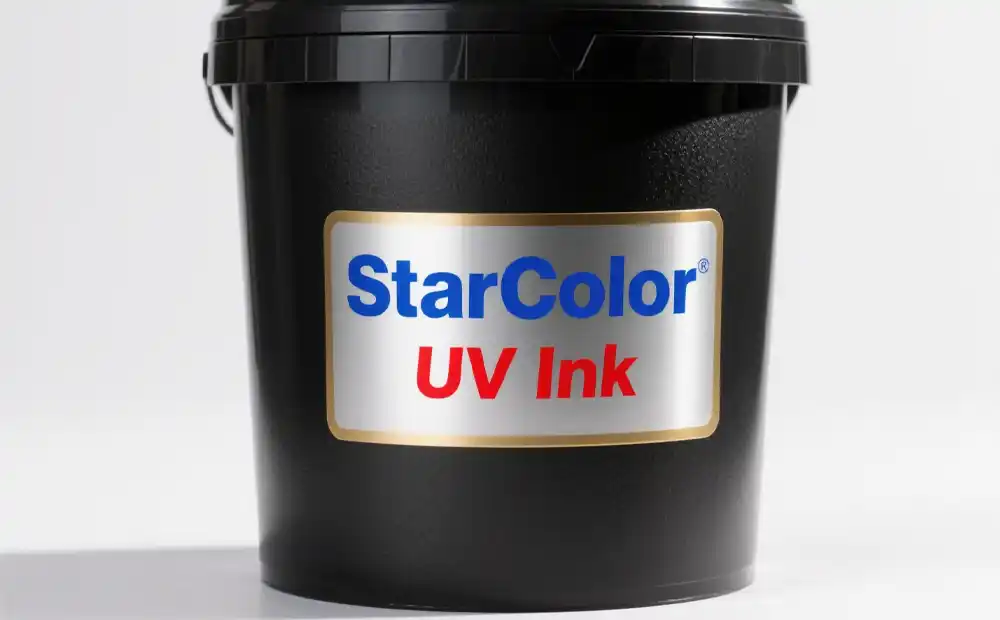 RU
RU
 EN
EN
 CN
CN

Position:HOME > Ink Knowledge > UV Ink
Date: Sep 01 2025 From: Star Color Views:
Water resistance is one of the key indicators of ink performance, especially for food packaging, beverage labels, and outdoor applications. Whether an ink can withstand exposure to water directly affects its functional reliability.
UV flexographic inks, with their crosslinked structure formed by ultraviolet curing, are often considered highly water-resistant. However, their actual performance depends on formulation, curing process, and substrate compatibility. Not all UV flexo inks can meet the stringent water-resistance requirements of demanding applications.
This article explores the question “Is UV flexographic ink waterproof?” from four perspectives: water-resistance mechanism, influencing factors, testing methods, and application optimization.
The water resistance of UV flexo inks originates from their unique curing mechanism. Under UV exposure, photo-initiators trigger free-radical polymerization of monomers and resins, forming a three-dimensional crosslinked network. This structure provides two core advantages:
High film density
UV curing happens almost instantaneously, creating a compact molecular network with extremely low porosity. This dense layer effectively blocks water penetration, preventing blistering or delamination.
Test data: In a 1-meter water immersion test, PET labels printed with UV flexo inks showed no blistering or discoloration after 24 hours. Adhesion remained at grade 4B.
Stable crosslinked structure
Once cured, the ink layer is chemically stable, insoluble in water, and resistant to hydrolysis.
Application case: Beverage labels printed with UV flexo inks can withstand hot filling at 85 °C, and after cooling, the ink layer remains intact without wrinkles or fading.

While UV flexo inks inherently perform better than solvent or water-based inks, poor formulation or process control can compromise results. The following factors play a decisive role:
Resin and monomer selection
The hydrophobicity and crosslink density of the resin system directly determine water resistance.
Degree of curing
Complete curing (≥90% conversion) ensures a dense network. Insufficient curing (<85%) leaves residual monomers that form “hydrophilic channels.”
Performance gap: Well-cured ink (≥90% crosslinking) shows only 0.3% water absorption after 24 hours in water at 25 °C, with adhesion maintained at grade 5B.
Poorly cured ink (≈70% crosslinking) absorbs up to 4.5% water, with adhesion falling to grade 2B.
Substrate compatibility
Strong adhesion between ink and substrate is crucial. Otherwise, water penetrates the interface, causing peeling.
Test result: On corona-treated BOPP film (surface tension 40 dyn/cm), UV flexo inks achieved grade 5B adhesion and survived 24-hour water immersion intact.
On untreated BOPP (32 dyn/cm), adhesion dropped to grade 2B, with partial delamination after just 6 hours.
Additive selection
Additives with hydrophilic groups can undermine water resistance. Hydrophobic, water-repellent options are preferred.
Recommended types:
Silicone-based leveling agents (e.g., polydimethylsiloxane) improve surface smoothness without reducing hydrophobicity.
Micronized polyethylene wax creates a protective surface film, raising water contact angle to ≈95°, enhancing repellency.
Evaluating water resistance requires standardized, quantitative testing:
Water Immersion Test
Standard: GB/T 1733-1993
Procedure: 10×10 cm printed sample is sealed at the edges, immersed in 25 °C water, and inspected after 2h, 4h, 8h, 24h.
Pass criteria: No blistering or discoloration after 24h, adhesion ≥ grade 3B, color difference ΔE ≤ 1.5.
Hot Water Resistance
Applications: Hot-fill beverages (80–95 °C), retort packaging (121 °C).
Procedure: Immersion in hot water for 1h, followed by cooling and abrasion test.
Pass criteria: At 85 °C, ink layer remains intact, abrasion resistance ≥ 300 cycles. At 121 °C, adhesion ≥ grade 2B.
Humidity Resistance (Condensation Test)
Standard: ISO 6270-2
Procedure: Exposure to 40 °C, 95% RH for 72h.
Pass criteria: No mold, wrinkling, or softening; hardness ≥ H.
Chemical Water Resistance (Acid/Alkali)
Applications: Packaging for acidic (vinegar, juice) or alkaline (soy sauce) foods.
Procedure: Immersion in 4% acetic acid and 5% sodium carbonate for 24h at 25 °C.
Pass criteria: No color loss or swelling; thickness change ≤ 5%.
Background:
A Chinese beverage producer used UV flexo PET labels with 20% HEA monomer. After 85 °C hot filling, ink blurred and edges lifted. After 24h immersion, adhesion dropped to 1B. Customer complaints reached 15%.
Optimization:
Formulation:
Replaced HEA with water-resistant acrylates (TMPTA).
Added 4% micronized polyethylene wax and 0.5% silicone leveling agent.
Curing Process:
Increased UV energy from 90 to 110 mJ/cm².
Reduced press speed from 320 to 280 m/min.
Used 500-line anilox roller (ink film ~2 μm).
Substrate Treatment:
Corona-treated PET, raising surface tension to 40 dyn/cm.
Results:
Water immersion: No blistering after 24h, adhesion grade 4B, ΔE=0.8.
Hot water: At 85 °C, no blurring; abrasion resistance 450 cycles.
Complaints: Dropped from 15% to 0.3%. Waste rate reduced from 8% to 1.2%, saving ≈$4,000/month.

So, is UV flexographic ink waterproof?
The answer: Yes, high-quality UV flexo inks with proper formulation, curing, and substrate treatment can achieve excellent water resistance, suitable for hot-fill beverages, outdoor humidity, and other demanding environments.
However, if formulation is poor, curing is incomplete, or adhesion is weak, water resistance can decline sharply — sometimes even performing worse than water-based inks.
Huizhou Zhongzhixing’s Starcolor UV flexographic inks are engineered for strong water resistance. If your packaging requires durable waterproof performance, feel free to contact us.